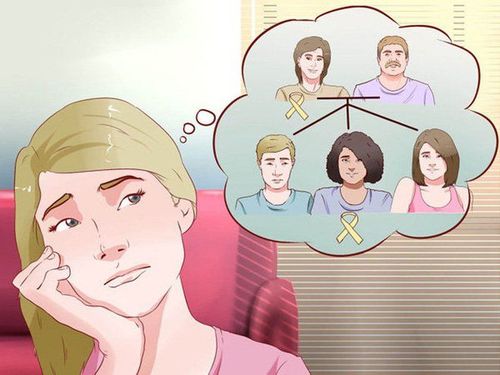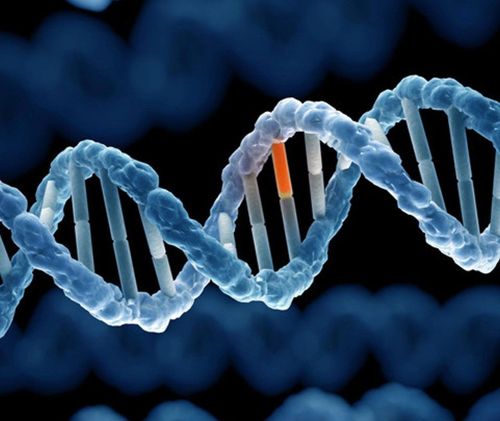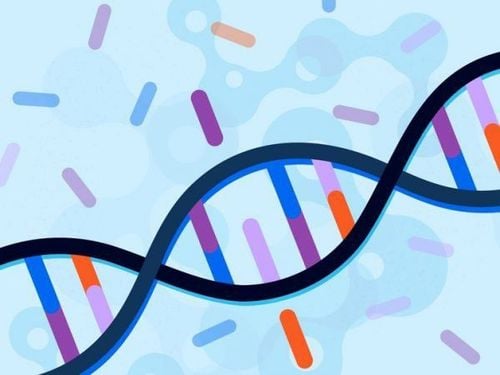This is an automatically translated article.
Article written by Doctor Hoang Quoc Chinh - High-tech Center
The reason why some people get cancer while others don't is not completely understood, but scientists have identified a number of factors that increase or decrease the risk of cancer. of an individual. This article provides basic knowledge about the cause-and-effect relationship between genes and cancer, to help readers better understand the role of genetic testing in inherited cancers.
1. What is a gene mutation?
The US National Cancer Institute defines cancer as a disease of genetic mutations. Gene mutations are changes in the sequence of a gene that result in changes in the function of the protein encoded by that gene.
Each protein performs one or more specific functions and works in conjunction with other molecules to ensure that the cell does its job well and interacts effectively with other cells. Good functioning and effective interaction are prerequisites for a healthy body, that is, a well-functioning system. However, under adverse environmental influences, genes can mutate meaning that one of the instructions is wrong, leading to failure to make, too much protein, or abnormal proteins to be made.
Since genes instruct the performance of a particular job, mutations in genes can lead to abnormalities in the cell's structure and/and function. As the number of abnormal cells increases, the structure or/and function of the organ (i.e., heart, lung, etc.) containing those cells will also change.
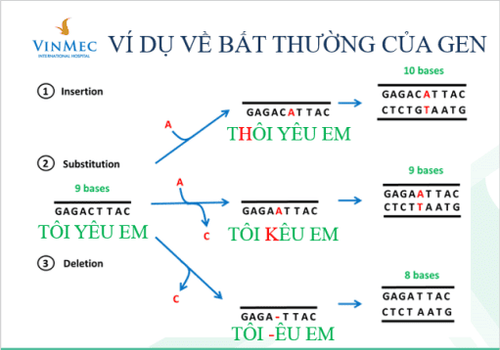
Ảnh minh họa các dạng đột biến điểm
2. Acquired and Hereditary Cancer
The collection of all the genes in a cell is called a genome. A human genome contains about 20 thousand protein-coding genes. With regard to cancer, genes can be divided into two categories as “oncogenes” and “genes that increase the risk of cancer”.
Oncogenes include genes whose normal function is to participate in the regulation of cell growth, development, and reproduction. Oncogenic mutations in these genes are usually mutations that increase the function of the proteins encoded by these genes.
For example, the KRAS gene encodes the KRAS protein. When the KRAS protein is in the active state, it signals the cell to reproduce, that is, to make more cells, when in the inactive state it tells the cell that reproduction is over, and cells stop reproducing.
Mutations that increase the function of the KRAS protein are the mutations that make the KRAS protein always active, so the cell continuously receives the reproductive signal, resulting in the production of a large number of cells. unnecessary. As cells continue to divide, they also continuously create new mutations. If new mutations occur in other cancer-causing genes, they turn a normal cell into a cancerous cell.
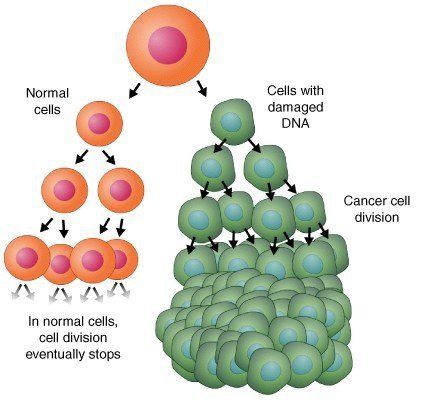
Tế bào bình thường (normal cells) đươc tạo ra để thực hiện một chức năng chuyên biệt và sẽ ngừng sinh sản khi đạt đến một số lượng nhất định. Tế bào ung thư (cancer cells) phân chia không ngừng và không thực hiện chức năng.
Cancer cells grow continuously and do not perform any specific function, leading to tumor formation. When the tumor is large enough, the cancer cells invade other organs and form tumors in those organs. This invasive process ends with functional paralysis of the entire body. Mutations in genes that cause cancer are called acquired mutations because these mutations often occur during the growth and development of the body and usually only occur in a group of cells in an organ. The acquired mutation may be the result of aging, exposure to carcinogens, and diet during development, so it is less likely to be passed on from generation to generation. another generation... Cancers caused by acquired mutations are called acquired cancers to distinguish them from inherited cancers. Acquired cancer accounts for about 80% of cancer patients.

Ung thư là quá trình tích lũy đột biến và diễn ra trong một thời gian dài (nhiều năm). Sàng lọc phát hiện sớm ung thư là phương pháp kiểm soát ung thư hữu hiệu nhất. (A) tế bào nhu mô bình thường. (B) khi một lượng nhỏ tế bào bị đột biến trên gen APC, thì những tế bào này bắt đầu phân chia liên tục để tạo ra khối u lành tính (Polys). (C và D) khối u lành tính sẽ tiếp tục biến đổi và trở thành khôi u ác tính khi bị thêm các đột biến gây bệnh ung thư (RAS và PI3K).
Cancer risk genes are genes whose normal function is to protect or correct errors when the genome is duplicated during cell division.
For example, cells contain genes whose function is to correct abnormalities of genome replication during cell reproduction. If these genes are inactivated, meaning that their repair function is reduced or completely lost, they either fail or perform poorly in the repair process, leading to the accumulation of mutations in newly born cells. out.
Genes that increase cancer risk are often mutated before or during zygote formation, meaning mutations are found in the father's sperm cells, the mother's egg, or when the sperm and egg combine combine to form a zygote. The zygote cell is the mother cell of all cells in the body, so if a mutation occurs at this stage it will be passed on to all other cells of the body including the zygote. reproductive. Only mutations that lose or decrease function on these genes increase the risk of cancer.
When these genes are lost or reduced in function, the cell accumulates new mutations. And if these mutations randomly occur in genes that cause cancer, then the process of cancer cell formation will occur similar to that described above. These mutations are called inherited mutations to distinguish them from acquired mutations, and cancers caused by these mutations are called hereditary cancers. An inherited mutation is a mutation that is inherited from a previous generation and is present in all cells in the body, so it is passed from generation to generation, and increases the risk of many types. cancer. Hereditary cancers account for about 20% of all cancer patients. The percentage of patients with hereditary cancer is high or low depending on the specific type of cancer. For example, our figures show that the prevalence of hereditary cancers in retinoblastoma is 55%.
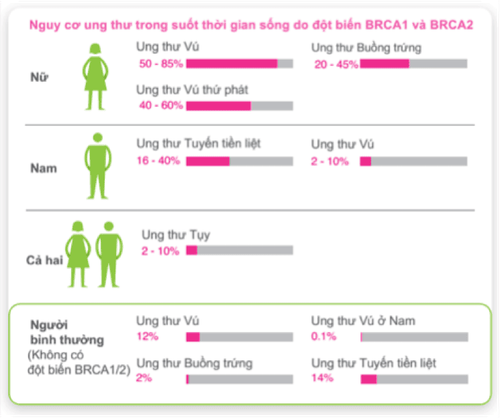
Đột biến di truyền trên gen BRCA1-2
The reason why some genetic mutation carriers don't get cancer while others get cancer is still unclear, but people who carry the genetic mutation have a higher risk of cancer relative to the population (most people).
For example, the incidence of breast cancer among carriers of an inherited mutation in the BRCA1 gene is 50-70% while the risk in the general population is 10%. This means that out of 100 people who carry an inherited mutation in the BRCA1 gene, between 50 and 70 will develop breast cancer at some point during their lifetime (up to age 80).
Genetic testing from blood cells or oral mucosa, thus allowing to determine the cause of cancer in cancer patients is due to inherited or acquired mutations. Based on the test results, the doctor will recommend appropriate treatment, plan to monitor the secondary cancers, and estimate the risk of cancer for the patient's family. For someone who hasn't had the disease, but has a family history of inherited cancers, this test helps plan follow-up for early detection, and take steps to reduce risk.
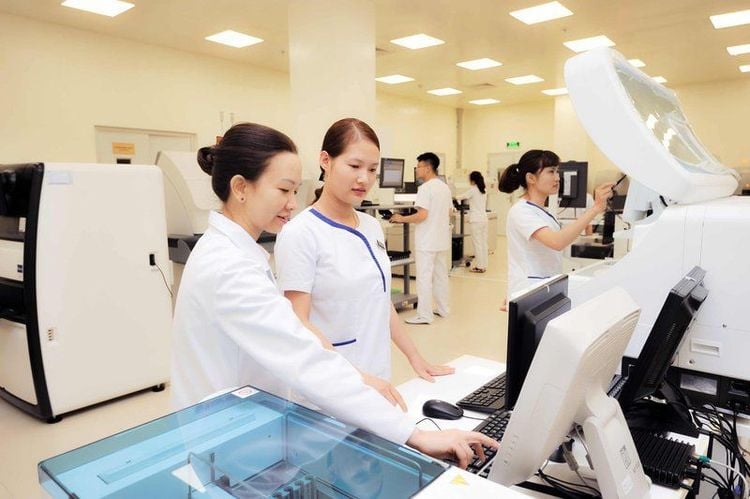
Xét nghiệm gen di truyền cần thực hiện tại cơ sở y tế uy tín
Because the mechanism of carcinogenesis is different between inherited and acquired cancers, the two cancers also have some different manifestations:
Hereditary cancers are caused, in part, by mutations Genetic variables are passed from generation to generation, so family members have a similar risk of developing cancer. Acquired cancer is caused by acquired mutations, mutations that occur during growth and development under the influence of environmental factors such as contaminated food, pollution, carcinogens, and old age. Most acquired mutations are not passed on from generation to generation, so other family members are less likely to carry the same type of cancer Inherited cancers often grow faster than acquired cancers. the same type of cancer, so experts often recommend genetic testing for young cancer patients and their families. Hereditary cancer can be more dangerous than acquired cancer. For example, hereditary prostate cancer is often more deadly and metastatic than acquired prostate cancer. Hereditary cancers may have a different response to treatment than acquired cancers of the same type. For example, PARP inhibitors are intended for patients with hereditary cancers with mutations in the BRCA gene. Keytruda is a drug for patients with hereditary cancers that carry mutations in the genes that cause Lynch syndrome. Patients with hereditary cancer may have more than one type of cancer, or cancer on both sides of the paired organs such as the eyes, kidneys, etc.
3. GEN Testing in Hereditary Cancer
After hundreds of years of research into the link between genetic mutations in cancer, scientists have identified thousands of genes that cause cancer or increase the risk of cancer. Based on scientific evidence and clinical trials, experts of world cancer associations have recommended genetic counseling and/or genetic testing for people with the following manifestations:
Self or other people The family had cancer at a young age. You or a family member has many different types of cancer. Self or family members have inherited cancer syndromes Self or family members have cancer on both sides of paired organs such as breast, kidney, eye...etc. Many people who are closely related have the same type of cancer. There are unusual cancer patients in the family. Ex: male breast cancer. Babies born with birth defects are linked to inherited cancer symptoms.
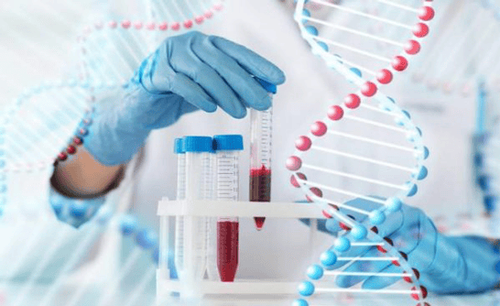
Xét nghiệm GEN giúp phát hiện sớm ung thư
Depending on your personal and family medical history, your doctor or genetic counselor will help you choose the right tests for the common hereditary cancers listed in Table I.
In addition to recommending While reporting the genes that need to be analyzed for each type of cancer, experts also recommend that the test be analyzed in laboratories with CAP, CLIA, and ISO 15189 certification. These quality certifications are the foundation. legal basis to show that the laboratory complies with international quality control standards, thus providing accurate results with high confidence.
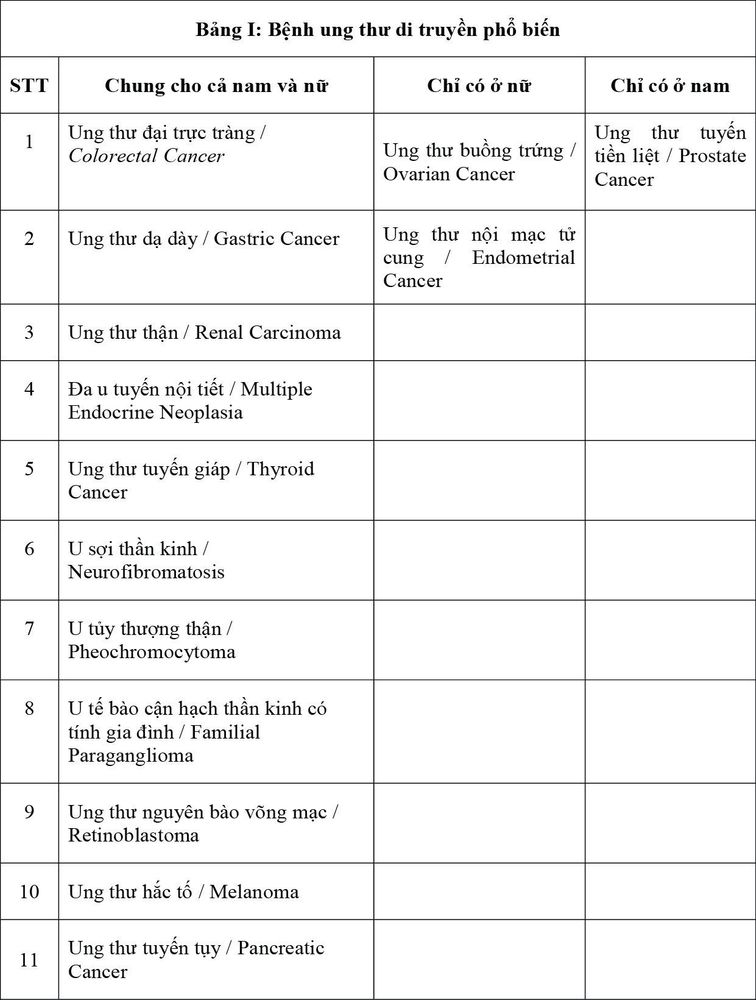
Vinmec International General Hospital is one of the hospitals that not only ensures professional quality with a team of leading medical doctors, modern equipment and technology, but also stands out for its examination and consultation services. comprehensive and professional medical consultation and treatment; civilized, polite, safe and sterile medical examination and treatment space.
Customers can directly go to Vinmec Health system nationwide to visit or contact the hotline here for support.
MORE:
What are the characteristics and properties of the human genome? Building a database of Vietnamese genomes Genetic testing to assess cancer risk





